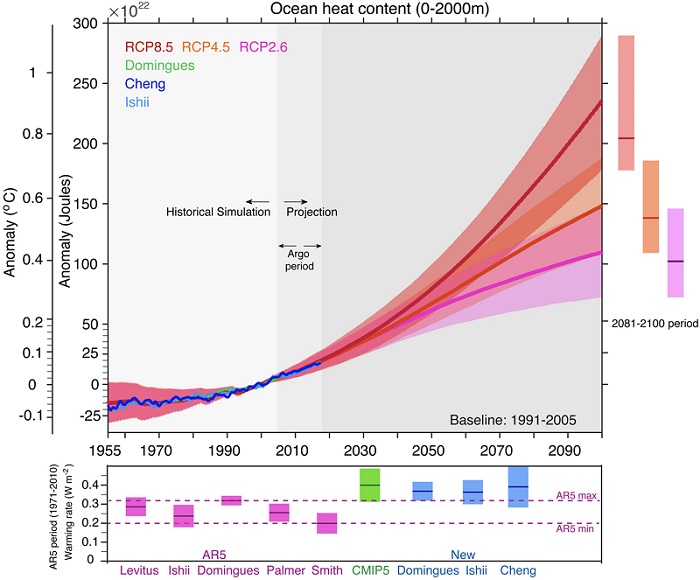Ocean Climate Observing Requirements in Support of Climate Research and Climate Information

Figure Observational ocean heat content changes for the upper 2000 m from in situ observations in Domingues et al. (2008), Cheng et al. (2017), and Ishii et al. (2017), compared with the ensemble means of the CMIP5 models for historical simulations pre-2005 and projections after 2005. Model calculations performed for emissions projections RCP2.6, RCP4.5 and RCP8.5 (Taylor et al., 2012). All error bars are 90% confidence interval. Credit: Lijing Cheng.
The ocean is an integral part of the climate system: understanding how intrinsic and externally forced variability have shaped it and it will change in the future is a major societal challenge. Key to understanding the ocean’s role in the Earth’s climate system is monitoring changes in the ocean circulation, heat and carbon content, freshwater, biogeochemical cycling and sea level, as well as studying the interactions of the ocean with the atmosphere, cryosphere, land, and ecosystems.
The CLIVAR Science Steering Committee (SSG) coordinated the co-chairs of its panels and research foci to produce a white paper for OceanObs’19 entitled ‘Ocean Climate Observing Requirements in Support of Climate Research and Climate Information’, that has recently been published in Frontiers in Marine Science. This paper reviews the space and time scales requirements of an ocean observing system for climate research, and revisits the question of which parameters such a system should encompass to meet current and future strategic goals of the World Climate Research Program (WCRP). It considers global as well as regional aspects that should be accounted for in designing observing systems in individual basins. Furthermore, the paper discusses which data-driven products are required to meet WCRP research and modeling needs, and ways to obtain them through data synthesis and assimilation approaches. Finally, it discusses the need for scientific capacity building and international collaboration in support of the collection of high-quality measurements over the large spatial scales and long time scales required for climate research, bridging the scientific rational to the required resources for implementation.
******************
Ocean Climate Observing Requirements in Support of Climate Research and Climate Information
Front. Mar. Sci., 31 July 2019 | https://doi.org/10.3389/fmars.2019.00444
Detlef Stammer1*, Annalisa Bracco2*, Krishna AchutaRao3, Lisa Beal4, Nathaniel L. Bindoff5,6, Pascale Braconnot7, Wenju Cai8, Dake Chen9, Matthew Collins10, Gokhan Danabasoglu11, Boris Dewitte12,13,14,15, Riccardo Farneti16, Baylor Fox-Kemper17, John Fyfe18, Stephen M. Griffies19, Steven R. Jayne20, Alban Lazar21, Matthieu Lengaigne22, Xiaopei Lin23,24, Simon Marsland25, Shoshiro Minobe26, Pedro M. S. Monteiro27, Walter Robinson28, Mathew Koll Roxy29, Ryan R. Rykaczewski30, Sabrina Speich31, Inga J. Smith32, Amy Solomon33, Andrea Storto34, Ken Takahashi35, Thomas Toniazzo36 and Jerome Vialard37
- Center für Erdsystemforschung und Nachhaltigkeit, Universität Hamburg, Hamburg, Germany
- School of Earth and Atmospheric Sciences, Georgia Institute of Technology, Atlanta, GA, United States
- Centre for Atmospheric Sciences, Indian Institute of Technology Delhi, New Delhi, India
- Rosenstiel School of Marine and Atmospheric Science, University of Miami, Miami, FL, United States
- Institute for Marine and Antarctic Studies, University of Tasmania, Hobart, TAS, Australia
- CSIRO Oceans and Atmospheres, Hobart, TAS, Australia
- Laboratoire des Sciences du Climat et de l’Environnement, unité mixte CEA-CNRS-UVSQ, Université Paris Saclay, Gif-sur-Yvette, France
- Centre for Southern Hemisphere Oceans Research, CSIRO, Aspendale, VIC, Australia
- State Key Laboratory of Satellite Ocean Environment Dynamics, Second Institute of Oceanography, State Oceanic Administration, Hangzhou, China
- College of Engineering, Mathematics and Physical Sciences, University of Exeter, Exeter, United Kingdom
- Climate and Global Dynamics Laboratory, National Center for Atmospheric Research, Boulder, CO, United States
- Centro de Estudios Avanzados en Zonas Áridas, Coquimbo, Chile
- Departamento de Biología, Facultad de Ciencias del Mar, Universidad Católica del Norte, Coquimbo, Chile
- Millennium Nucleus for Ecology and Sustainable Management of Oceanic Islands (ESMOI), Coquimbo, Chile
- LEGOS, Université de Toulouse, IRD, CNES, CNRS, UPS, Toulouse, France
- Earth System Physics Section, Abdus Salam International Centre for Theoretical Physics, Trieste, Italy
- Department of Earth, Environmental, and Planetary Sciences, Brown University, Providence, RI, United States
- Canadian Centre of Climate Modelling and Analysis, Environment and Climate Change Canada, Victoria, BC, Canada
- NOAA Geophysical Fluid Dynamics Laboratory, Princeton, NJ, United States
- Department of Physical Oceanography, Woods Hole Oceanographic Institution, Woods Hole, MA, United States
- CNRS, IRD, MNHN, Laboratoire d’Océanographie et du Climat: Expérimentations et Approches Numériques, Sorbonne Université, Paris, France
- Laboratory of Oceanography and Climate: Experiments and Numerical Approaches, Institute of Research for Development, Paris, France
- Physical Oceanography Laboratory, Institute for Advanced Ocean Studies, Ocean University of China, Qingdao, China
- Qingdao National Laboratory for Marine Science and Technology, Qingdao, China
- CSIRO Climate Science Centre, Canberra, ACT, Australia
- Department of Earth and Planetary Sciences, Faculty of Science, Hokkaido University, Sapporo, Japan
- Southern Ocean Carbon – Climate Observatory, CSIR, Cape Town, South Africa
- Department of Marine, Earth, and Atmospheric Sciences, North Carolina State University, Raleigh, NC, United States
- Centre for Climate Change Research, Indian Institute of Tropical Meteorology, Pune, India
- School of the Earth, Ocean, and Environment, University of South Carolina, Columbia, SC, United States
- UMR8539, IPSL, ENS – PSL, Laboratoire de Météorologie Dynamique, Paris, France
- Department of Physics, University of Otago, Dunedin, New Zealand
- Earth System Research Laboratory, National Oceanic and Atmospheric Administration, Cooperative Institute for Research in Environmental Sciences, University of Colorado, Boulder, Boulder, CO, United States
- Centre for Maritime Research and Experimentation, La Spezia, Italy
- Servicio Nacional de Meteorología e Hidrología del Perú, Instituto Geofisico del Peru, Lima, Peru
- Bjerknes Centre for Climate Research, University of Bergen, Bergen, Norway
- IRD, IPSL, CNRS, IRD, MNHN, LOCEAN Laboratory, Sorbonne University, Paris, France














Add new comment